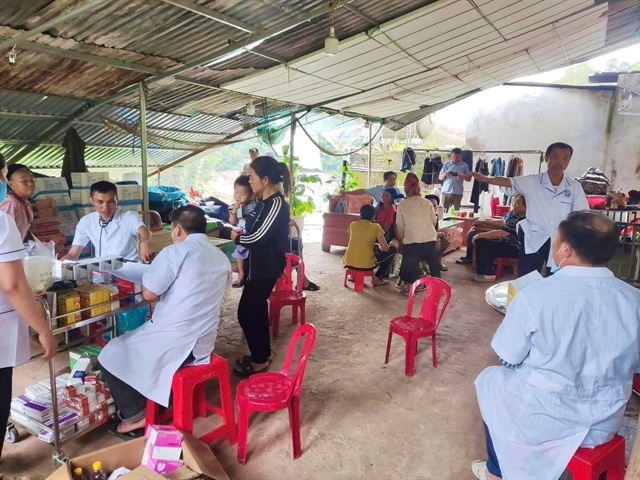 Environment
Environment

 |
| A field hospital is set up in Mỹ Lý Commune of Nghệ An Province to ensure health care for local residents. — VNA/VNS Photo |
NGHỆ AN — Following the historic floods in the central province of Nghệ An, residents and authorities are taking urgent measures to ensure hygiene in their living environment and prevent post-flood diseases.
The mountainous Tương Dương Commune was among the hardest hit by Typhoon Wipha on July 22.
Vi Thị Hoài, who lives in the commune’s Hòa Đồng Hamlet, said her family resorted to using the murky water from Lam River to clean their home, which was buried under nearly half a metre of mud.
“Dead animals were everywhere. Many locals, including myself, have started to suffer from waterborne skin infections and rashes,” she said.
The ongoing shortage of clean water has severely hampered hygiene efforts in the area.
While local authorities and volunteers have been working tirelessly to provide help to households, the need for clean water and medical supplies remains critical.
Cases of skin infections, diarrhoea and conjunctivitis have been reported.
Tương Dương Health Centre has been enhancing public health education campaigns, encouraging hygiene practices and disease prevention, but more support is needed, particularly in terms of disinfectants and medical supplies.
Dr Trần Văn Công, the centre’s deputy director, said: “We are in urgent need of electric and fuel-powered sprayers to disinfect the surrounding environment and curb disease spread.”
Various health facilities in Tương Dương, Kỳ Sơn and Mỹ Lý communes suffered heavy damage due to Typhoon Wipha-induced floods.
Local authorities are actively working with Nghệ An Province to procure the supplies to ensure public health and hygiene, according to Tương Dương People’s Committee chairman Nguyễn Hồng Tài.
Meanwhile, across flood-hit communes in western Nghệ An, teachers, youth union members, border guards and police officers are taking up cleaning tasks to ensure environmental sanitation.
Health workers are also going door-to-door in villages, guiding residents on water treatment, food safety and livestock sanitation.
Quick response
Immediately after the floods, the Nghệ An Health Department dispatched response teams to affected areas to provide emergency support.
The provincial Centre for Disease Control (CDC) has also distributed water purification tablets and water containers to medical centres in Kỳ Sơn, Tương Dương, Con Cuông, Anh Sơn, Quỳ Châu and Quế Phong to make sure that locals have safe drinking water.
According to Nghệ An CDC, floodwaters often leave behind waste, animal carcasses and contaminated soil, which provide ideal conditions for the spread of dangerous diseases such as cholera, typhoid, conjunctivitis, respiratory infections, skin diseases, influenza and dengue fever.
In response, the provincial CDC has ramped up surveillance, provided early disease detection and offered sanitation guidance to local authorities.
In 2025, the centre has already distributed two batches of Cloramin B disinfectant to 20 district-level health centres as part of its flood preparedness strategy.
Nghệ An Department of Health has also issued an official directive requiring all medical units to proactively implement measures for disease prevention, environmental sanitation, food safety and uninterrupted healthcare services following flooding and waterlogging.
According to the document, health facilities must review and identify high-risk areas for potential outbreaks, and arrange sufficient medical personnel and supplies to support monitoring, early detection and a fast response to infectious diseases.
In addition to ensuring proper use of insecticides and disposal of animal carcasses, the provincial health department also stressed the need to ramp up public communication efforts, guiding residents on clean water treatment, food safety, and the prevention of common post-flood illnesses, especially at evacuation sites and isolated areas. — VNS




